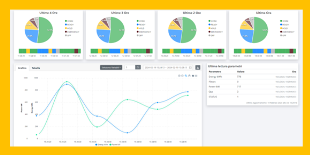Details
The new solution from Retuner enhances and extends the capabilities of MiniMES5.0 to new areas for monitoring, control and management of the entire factory environment.
xMES is a next-generation extended Manufacturing Execution System, enabling the maximum integration of Industry 5.0 processes within the production layout.
BENEFITS
- Flexible scheduling
- Intralogistics
- Shift and personnel management
- Maintenance of production assets
- Supply chain integration
- ESG monitoring starting from energy consumption

The MES extended to the monitoring of corporate ESG metrics
In a manufacturing company, sustainability is approached from environmental, economic, and social perspectives. This enables the improvement of the efficiency of production processes, leading to savings in energy resources, raw materials, manual processing times on machines, and personnel.
The new TRANSITION 5.0 Plan focuses on enhancing the efficiency of production processes for energy resource savings, aligning it with energy production and self-consumption.
xMES includes functionalities for monitoring energy consumption and all parameters contributing to the company’s ESG (Environmental, Social, Governance) metrics.
With xMES, data collected from the field, certified, and real-time normalized by other components of the RETUNER® suite can be analyzed in terms of ENERGY. Using drill-down techniques, one can define the energy consumption for each process and for each individual product.
Energy consumption thus becomes a monitored and traced variable for each production and product. The integral calculation between energy consumed and the quantity of product obtained in each process allows for measuring the trend of energy consumption per equivalent production.
Through integrated data management and analysis of historical production process series intersected with purchased or self-produced energy costs, it is possible to highlight trends in consumption relative to production and define the carbon footprint of each individual product.
MES for intralogistics
In manufacturing companies, intralogistics is becoming increasingly crucial for improving corporate competitiveness. Today, the logistical flows of goods and materials within a company are constituted by systems and facilities characterized by progressive and high levels of automation, such as automatic warehouses, and technological components like mechanical and pneumatic feeders, lifting devices, sensors, robots, palletizers, packaging systems, data management systems, and logistics software.
xMES integrates within its functionalities the management of intra-company flows of semi-finished and finished products. It allows for the management and tracking of material withdrawals from raw material warehouses to the depositing of finished product production, through all stages of the production cycle.
Furthermore, it offers functionality for controlling the raw material withdrawn by scanning its barcode, with a block on the start of processing if the material does not correspond to what is expected for the particular processing or machine. This prevents potential errors that, in extreme cases, can lead to machine downtime, resulting in productivity losses and machinery repair costs.
The “smart” management of materials in transit within the plant is complemented by simple and standardized integration through Restful API interfaces with other systems such as ERP, MRP, or WMS already present in the company.
Through these integrations, xMES becomes an integral part of the IT infrastructure, automatically communicating to third-party systems the consumption of raw materials and the depositing of finished and semi-finished products as soon as processing is complete.
Thanks to these features, xMES can manage an increasingly wide range of intralogistics process stages, gradually integrating the entire supply chain, both inbound and outbound.
Download our practical guide to the Transition 5.0 Plan
Architecture
The RETUNER solution, placed between the factory and the organizational structure, connects and integrates the two levels according to a model of loose coupling. The main advantage is that the two levels can evolve independently over time, allowing for the change of machinery on one side or the replacement of application software on the other, without affecting their interconnection and integration.
Read more